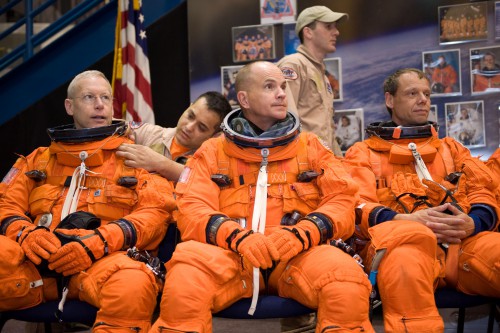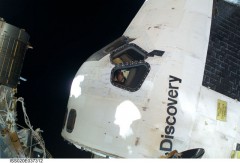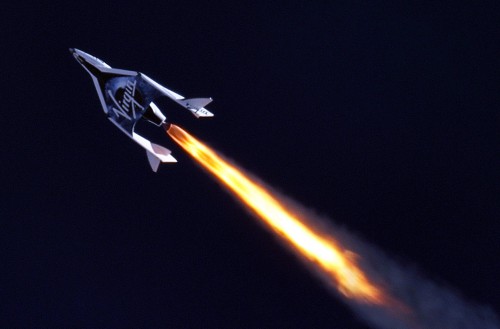
Only days after triumphantly testing SpaceShipTwo on its first powered flight above the Mojave Air and Space Port, Calif., Virgin Galactic has announced that former astronaut Rick “C.J.” Sturckow has joined its commercial team of pilots. Sturckow left NASA earlier this spring after an 18-year tenure with the agency. He is a veteran of four shuttle missions, including STS-88, which began the storied construction of the International Space Station back in December 1998. Also named to Virgin Galactic’s team was retired U.S. Air Force Lieutenant-Colonel Michael “Sooch” Masucci, a former Citation X captain for the private airline XOJET Inc. and a veteran U-2 combat pilot.
Sturckow was selected as an astronaut in December 1994, after serving as a fighter and test pilot in the U.S. Marine Corps. He flew 41 combat missions during Operation Desert Storm over Iraq. He was the second pilot of his NASA class to draw a flight assignment, being named to the coveted STS-88 mission to begin ISS assembly. Subsequent flights also visited the evolving station—STS-105 in August 2001, STS-117 in June 2007, and STS-128 in August-September 2009—and this made Sturckow the first person to travel as many as four times to the ISS. (This record has since been matched by fellow astronaut Mark Kelly and will shortly also be matched by Russia’s Fyodor Yurchikhin, who is due to launch toward the station on his fourth mission on 28 May.)

After his final shuttle flight, Sturckow served as Deputy Chief of the Astronaut Office and in January 2011 was again thrust into the limelight when Arizona Congresswoman Gabrielle Giffords—wife of STS-134 commander Mark Kelly—was shot during an attempted assassination. Sturckow was named as backup commander, enabling Kelly to care for his wife, although the STS-134 ultimately flew as scheduled in May-June 2011. Despite some Internet speculation that Sturckow was hopeful for a long-duration ISS expedition, this never transpired and he retired from NASA in March 2013.
Whilst Sturckow’s presence at Virgin Galactic has drawn a number of raised eyebrows, since he is the first former astronaut chosen as a member of its flight team, his colleague Masucci has equally impressive credentials. A 30-year veteran of civilian and military aviation, and a U.S. Air Force test pilot, he served as an instructor on the F-16 Fighting Falcon and the T-38 Talon, as well as developing and testing the U-2’s glass cockpit and power upgrade programs. “I am pleased to have these two incredibly accomplished pilots join us during this important time as we embark on a series of important rocket-powered flight tests for SpaceShipTwo, ultimately testing the vehicle in space,” said Virgin Galactic President and CEO George Whitesides. “Their collective experience and outstanding performance in various demanding environments will make them invaluable assets to the Virgin Galactic team.”

Virgin Galactic—a subsidiary of Sir Richard Branson’s Virgin brand—seeks to provide suborbital spaceflights for tourists at a reported price of around $200,000 per seat. After more than three years of design and testing, its SpaceShipTwo vehicle was successfully deployed into free flight at an altitude of 47,000 feet from the WhiteKnightTwo carrier aircraft on 29 April. Aboard SpaceShipTwo were Scaled Composites test pilots Mark Stucky and Mike Alsbury, who oversaw the ignition of the craft’s RocketMotorTwo and achieved a peak velocity of Mach 1.2.
The exact date for SpaceShipTwo’s first passenger-carrying flight remains unknown, although the 29 April powered test will certainly imbue Virgin Galactic with confidence that it is drawing inexorably closer. Current plans are that the craft will reach an apogee of 110 km (68 miles), which is 10 km (6 miles) higher than the “Kármán Line,” named after Theodore von Kármán, the Hungarian-American engineer who first described it as the altitude at which the atmosphere is too thin for aeronautical purposes, since a vehicle would need to travel faster than orbital velocity to achieve sufficient lift. The craft’s RocketMotorTwo—a hybrid engine, fueled with hydroxyl-terminated polybutadiene and nitrous oxide, and capable of 60,000 pounds of thrust—has been built by Sierra Nevada Corp. and will achieve a maximum velocity of 2,600 mph. SpaceShipTwo will then utilize its “feathered” re-entry system to guide it through the atmosphere toward a touchdown back at the spaceport.
A new generation of “astronauts” are expected to be created through Virgin Galactic’s grandiose plans, with fare-paying passengers expected to be honoured after their flights with unique “space stamps” on their passports. And for Rick Sturckow, perhaps, the end of his NASA spaceflying career marks just the start of another stellar career in exploring the final frontier.
Want to keep up-to-date with all things space? Be sure to “Like” AmericaSpace on Facebook and follow us on Twitter:@AmericaSpace




Experience makes the difference! Sounds like Virgin Galactic is deeply serious of hiring experienced astronauts for powered flights. Wish I could afford to fly in the back seat on one. Maybe someday if I win the lottery!